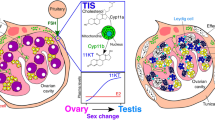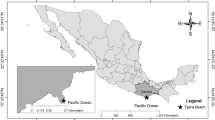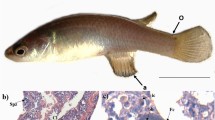Abstract
The three-spot wrasse (Halichoeres trimaculatus), which inhabits the coral reefs of Okinawa, changes sex from female to male. Sex change in this species is controlled by a social system. Oocytes disappear completely from the ovary, and male germ cells and somatic cells comprising testicular tissue arise a new during the sex change process. However, little is known of the fate and origin of the gonadal tissue-forming cells during sex change. In particular, the fate of ovarian somatic cells has not been determined, although the ovarian tissue regresses histologically. To approach this question, we analyzed apoptosis and cell proliferation in the sex-changing gonads. Unexpectedly, we found that few apoptotic somatic cells were present during sex change, suggesting that ovarian somatic cells might survive during the regression of the ovarian tissue. On the other hand, cell proliferation was detected in many granulosa cells surrounding the degenerating oocytes, a few epithelial cells covering ovigerous lamella and a few somatic cells associated with gonial germ cells at an early stage of sex change. Then, we found that proliferative ovarian somatic cells remained in the gonads late in the sex change process. Based on these results, we concluded that some functional somatic cells of the ovary are reused as testicular somatic cells during the gonadal sex change in the three-spot wrasse.


Similar content being viewed by others
References
Asoh K (2004) Gonadal development in the coral-reef damselfish Dascyllus flavicaudus from Moorea, French Polynesia. Mar Biol 146:167–179
Bhandari RK, Komuro H, Nakamura S, Higa M, Nakamura M (2003) Gonadal restructuring and correlative steroid hormone profiles during natural sex change in protogynous honeycomb grouper, Epinephelus merra. Zool Sci 20:1399–1404
Candi G, Castriota L, Andaloro F, Finoia MG, Marino G (2004) Reproductive cycle and sex inversion in razor fish, a protogynous labrid in the southern Mediterranean Sea. J Fish Biol 64:1498–1513
Higa M, Ogasawara K, Sakaguchi A, Nagahama Y, Nakamura M (2003) Role of steroid hormones in sex change of protogynous wrasse. Fish Physiol Biochem 28:149–150
Kokokiris L, Fostier A, Athanassopoulou F, Petridis D, Kentouri M (2006) Gonadal changes and blood sex steroids levels during natural sex inversion in the protogynous Mediterranean red porgy, Pagrus pagrus (Teleostei: Sparidae). Gen Comp Endocrinol 149:42–48
Kuwamura T, Suzuki S, Tanaka N, Ouchi E, Karino K, Nakashima Y (2007) Sex change of primary males in a diandric labrid Halichoeres trimaculatus: coexistence of protandry and protogyny within a species. J Fish Biol 70:1898–1906
Lee YH, Du JL, Yueh WS, Lin BY, Huang JD, Lee CY, Lee MF, Lau EL, Lee FY, Morrey C, Nagahama Y, Chang CF (2001) Sex change in the protandrous black porgy, Acanthopagrus schlegeli: a review in gonadal development, estradiol, estrogen receptor, aromatase activity and gonadotropin. J Exp Zool 290:715–726
Mackie MC (2006) Anatomical changes to the gonad during protogynous sex change in the half-moon grouper Epinephelus rivulatus (Valenciennes). J Fish Biol 69:176–186
McBride RS, Johnson MR (2007) Sexual development and reproductive seasonality of hogfish (Labridae: Lachnolaimus maximus), an hermaphroditic reef fish. J Fish Biol 71:1270–1292
Nakamura M, Hourigan T, Yamauchi K, Nagahama Y, Grau EG (1989) Histological and ultrastructural evidence for the role of gonadal steroid hormones in sex change in the protogynous wrasse Thalassoma duperrey. Environ Biol Fish 24:117–136
Nozu R, Kojima Y, Nakamura M (2009) Short term treatment with aromatase inhibitor induces sex change in the protogynous wrasse, Halichoeres trimaculatus. Gen Comp Endocrinol 161:360–364
Sunobe T, Nakamura M, Kobayashi Y, Kobayashi T, Nagahama Y (2005) Gonadal structure and P450scc and 3β-HSD immunoreactivity in the gobiid fish Trimma okinawae during bidirectional sex change. Ichthyol Res 52:27–32
Acknowledgments
This study was supported by a Grant-in-Aid for Science Research from the Ministry of Education, Science, Sports and Culture of Japan and Solution-Oriented Research for Science and Technology from Japan Science and Technology Agency.
Author information
Authors and Affiliations
Corresponding author
Rights and permissions
About this article
Cite this article
Nozu, R., Horiguchi, R., Murata, R. et al. Survival of ovarian somatic cells during sex change in the protogynous wrasse, Halichoeres trimaculatus . Fish Physiol Biochem 39, 47–51 (2013). https://doi.org/10.1007/s10695-012-9632-2
Received:
Accepted:
Published:
Issue Date:
DOI: https://doi.org/10.1007/s10695-012-9632-2




